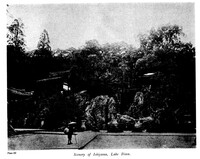As far back as the middle of the eighth century, a monastery was founded upon this beautiful wooded eminence. Its position on the banks of the Setagawa, just at the point where that river runs into Lake Biwa, gives it the advantage of a commanding view of the surrounding scenery. The spot has become famous as the retreat of the talented authoress Murasaki Shikibu, who, in monastic seclusion and inspired by the lovely prospect of Lake Biwa, here wrote her historical romance-Genji Monogatari. Ishiyama, or the Rocky Mountain, receives its name from the colossal natural rocks which project here and there from the rich surrounding soil on which maples and pine trees flourish in great profusion. Notwithstanding their elevation, these quaintly shaped monoliths bear the abrased and excoriated markings peculiar to stones long subjected to the wearing and decomposing action of water. Sea-rocks and river boulders of similar character are extensively used in the landscape gardens of the country, and the ancient rockeries of Ishiyama may be taken as one example amongst many in which this charming peculiarity of Japanese gardening finds its prototype and model in natural scenery. The priests of the temple have taken advantage of these picturesque rock masses to convert the surrounding hill-sides into a beautiful landscape garden on a gigantic scale.

